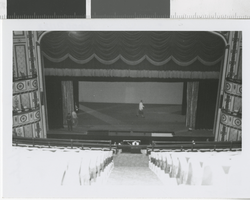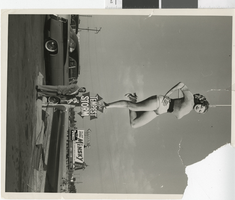Search the Special Collections and Archives Portal
Search Results

Photographs of female Minsky's cast members' close-ups, 1970-1979
Date
1970 to 1979
Archival Collection
Description
A 30-photograph proof sheet of several female Minsky's cast members displaying costumes in various poses. Eleven of the photos are head shots of a female cast member wearing a black and white striped top. Fifteen of the photos are head shots of a showgirl wearing a white top. Four of the photos feature more of the costume pieces.
Image

Photographs of a topless Minsky's cast member in costume, 1970-1979
Date
1970 to 1979
Archival Collection
Description
A 12-photograph proof sheet of Minsky's female cast members displaying costumes in various poses. Six of the photos feature a showgirl photographed from the waist down, wearing a beaded sarong-style skirt. Six of the photos feature a topless showgirl wearing a rhinestone embelished bikini-style costume. Four of the photos show a feathered costume piece.
Image

Photograph of the interior of the Shubert Theatre, Cincinnati (Ohio), 1970
Date
1970
Archival Collection
Description
The Shubert Theatre stage as seen from the balcony. Four sections of box seats are visible as well as the orchestra pit. Two unidentified men are on the stage as the screen is being positioned. The 3,000 seat Shubert Theater was built inside what was originally the city’s original YMCA (which opened in 1848). The theater opened in 1921 as a venue for legitimate theatrical performances. The Shubert Theater switched to a combined use venue for movies and stage shows in 1935. The theater was closed in 1953 and reopened as Rev. Earl Ivies' Revival Temple. Just two years later, however, the Shubert Theater was renovated and once again returned to legitimate theater. In 1976, the Shubert Theater was demolished to make way for a parking lot. Today, there is an office building on the site. Site Name: Shubert Theater (Cincinnati, Ohio) Street Address: 90 East 7th Street
Image

Photograph of the interior of the Shubert Theatre, Cincinnati (Ohio), 1970
Date
1970
Archival Collection
Description
The Shubert Theatre stage as seen from the upper balcony. Two sections of box seats are visible as well as the orchestra pit. The 3,000 seat Shubert Theater was built inside what was originally the city’s original YMCA (which opened in 1848). The theater opened in 1921 as a venue for legitimate theatrical performances. The Shubert Theater switched to a combined use venue for movies and stage shows in 1935. The theater was closed in 1953 and reopened as Rev. Earl Ivies' Revival Temple. Just two years later, however, the Shubert Theater was renovated and once again returned to legitimate theater. In 1976, the Shubert Theater was demolished to make way for a parking lot. Today, there is an office building on the site. Site Name: Shubert Theater (Cincinnati, Ohio) Street Address: 90 East 7th Street
Image

Photograph of the interior of the Shubert Theatre, Cincinnati (Ohio), 1970
Date
1970
Archival Collection
Description
The Shubert Theatre stage as seen from the upper house left side of the balcony seats. Two sections of box seats are visible. The intricate wall designs are visible above the box seats and above the exit for the balcony rows. The 3,000 seat Shubert Theater was built inside what was originally the city’s original YMCA (which opened in 1848). The theater opened in 1921 as a venue for legitimate theatrical performances. The Shubert Theater switched to a combined use venue for movies and stage shows in 1935. The theater was closed in 1953 and reopened as Rev. Earl Ivies' Revival Temple. Just two years later, however, the Shubert Theater was renovated and once again returned to legitimate theater. In 1976, the Shubert Theater was demolished to make way for a parking lot. Today, there is an office building on the site. Site Name: Shubert Theater (Cincinnati, Ohio) Street Address: 90 East 7th Street
Image

Photograph of the stage area of the Shubert Theatre, Cincinnati (Ohio), 1970
Date
1970
Archival Collection
Description
Three unidentified men on the stage of the Shubert Theatre as seen from the balcony seats. The 3,000 seat Shubert Theater was built inside what was originally the city’s original YMCA (which opened in 1848). The theater opened in 1921 as a venue for legitimate theatrical performances. The Shubert Theater switched to a combined use venue for movies and stage shows in 1935. The theater was closed in 1953 and reopened as Rev. Earl Ivies' Revival Temple. Just two years later, however, the Shubert Theater was renovated and once again returned to legitimate theater. In 1976, the Shubert Theater was demolished to make way for a parking lot. Today, there is an office building on the site. Site Name: Shubert Theater (Cincinnati, Ohio) Street Address: 90 East 7th Street
Image

Photograph of a billboard for Minsky's Burlesque, Las Vegas (Nev.), November, 1972
Date
1972-11
Archival Collection
Description
A outdoor billboard with a picture of a showgirl and the words: "Minsky's Burlesque '72, Aladdin Hotel."
Image

Photograph of a cutout billboard of Miss Tempest Storm, 1970-1979
Date
1970 to 1979
Archival Collection
Description
Tempest Storm's agent stands underneath a billboard of her. A billboard advertising "All New Daringly Different Minsky Now at the Dunes" is visible in the background.
Image

Photograph of the Aladdin Hotel marquee, Las Vegas (Nev.), 1972
Date
1972
Archival Collection
Description
A nighttime view of the Aladdin Hotel marquee advertising Minsky's Burlesque '72 in the Bagdad Theatre featuring Tommy "Moe" Raft and Jerry Norman. A secondary marquee advertises gourmet dining in the Sabre Room. The Aladdin opened on April 1, 1966 and closed on November 25, 1997, and was imploded on 7:30pm, on April 27, 1998, except for the Aladdin Theatre to make way for the construction of an entirely new casino. The new Aladdin was scheduled to reopen on August 17, 2000, at 6:00 p.m. The opening was delayed while the Clark County building inspector completed its fire safety testing. Another delay was caused by last-minute repairs to the casino surveillance system. The new Aladdin finally opened the next day at 7:45 a.m. The casino was sold in bankruptcy on June 20, 2003 to a partnership of Planet Hollywood and Starwood Hotels & Resorts Worldwide. Renovations were carried out in stages, allowing the resort to remain open throughout. The retail space formerly known as "The Desert Passage" was converted into the Hollywood-themed "Miracle Mile Shops" and the theatre formerly known as the "Aladdin Theatre" was converted into "The AXIS". After the casino was renovated, it was reopened as "Planet Hollywood Resort & Casino" on April 17, 2007. Site Name: Aladdin Hotel (Las Vegas, Nev.) Street Address: 3667 South Las Vegas Boulevard
Image

Photograph of the Thunderbird marquee, Las Vegas (Nev.), 1970-1979
Date
1970 to 1979
Archival Collection
Description
A nighttime photograph of the Thunderbird marquee advertising "Kings IV, Buckley and Collins," and "Thoroughly Modern Minsky World Famous Burlesque produced by Harold Minsky in the Continental Theatre. Showtimes 8:15 and midnight plus Fri. + Sat. 2:30 A.M." On September 2, 1948, the Thunderbird Hotel was the fourth resort to open on the Las Vegas Strip. The resort was built by developer Marion Hicks and owned by Lieutenant Governor of Nevada Clifford A. Jones. The resort had a Native American theme and featured portraits, a Navajo-based restaurant, the only bowling alley ever on the Strip, and a showroom. In 1955, articles surfaced in the Las Vegas Sun saying that Meyer Lansky and other underworld figures held hidden shares in the hotel. In 1964, the casino was purchased by Del Webb for $10 million. He ran the resort until 1972, when he sold it to Caesars World, owner of Caesars Palace, for $13.6 million. A $150-million, 2,000-room resort called the Mark Anthony was planned for the site, but Caesars was unable to find financing, and sold the property four years later to banker E. Parry Thomas at a loss of $5.7 million. Thomas later sold it to Major Riddle, owner of the Dunes Hotel, who renamed the resort as the Silverbird in 1976. The Thunderbird has the distinction of being the resort where singer Rosemary Clooney made her first appearance in Las Vegas in 1951, and where Judy Garland made her final Vegas appearance in 1965. Site Name: Thunderbird Hotel (Las Vegas, Nev.) Street Address: 2755 South Las Vegas Boulevard
Image
Pagination
Refine my results
Content Type
Creator or Contributor
Subject
Archival Collection
Digital Project
Resource Type
Year
Material Type
Place
Language
